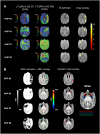Spatio-Temporal Characterization of Brain Inflammation in a Non-human Primate Stroke Model Mimicking Endovascular Thrombectomy
- PMID: 36976495
- PMCID: PMC10275847
- DOI: 10.1007/s13311-023-01368-2
Spatio-Temporal Characterization of Brain Inflammation in a Non-human Primate Stroke Model Mimicking Endovascular Thrombectomy
Abstract
Reperfusion therapies in acute ischemic stroke have demonstrated their efficacy in promoting clinical recovery. However, ischemia/reperfusion injury and related inflammation remain a major challenge in patient clinical management. We evaluated the spatio-temporal evolution of inflammation using sequential clinical [11C]PK11195 PET-MRI in a non-human primate (NHP) stroke model mimicking endovascular thrombectomy (EVT) with a neuroprotective cyclosporine A (CsA) treatment. The NHP underwent a 110-min transient endovascular middle cerebral artery occlusion. We acquired [11C]PK11195 dynamic PET-MR imaging at baseline, 7 and 30 days after intervention. Individual voxel-wise analysis was performed thanks to a baseline scan database. We quantified [11C]PK11195 in anatomical regions and in lesioned areas defined on per-occlusion MR diffusion-weighted imaging and perfusion [15O2]H2OPET imaging. [11C]PK11195 parametric maps showed a clear uptake overlapping the lesion core at D7, which further increased at D30. Voxel-wise analysis identified individuals with significant inflammation at D30, with voxels located within the most severe diffusion reduction area during occlusion, mainly in the putamen. The quantitative analysis revealed that thalamic inflammation lasted until D30 and was significantly reduced in the CsA-treated group compared to the placebo. In conclusion, we showed that chronic inflammation matched ADC decrease at occlusion time, a region exposed to an initial burst of damage-associated molecular patterns, in an NHP stroke model mimicking EVT. We described secondary thalamic inflammation and the protective effect of CsA in this region. We propose that major ADC drop in the putamen during occlusion may identify individuals who could benefit from early personalized treatment targeting inflammation.
Keywords: Endovascular thrombectomy; Inflammation; PET-MRI; Stroke; TSPO.
© 2023. The Author(s).
Conflict of interest statement
Ocean Wateau is an employee of Cynbiose SAS. The authors have declared that no competing interest exists.
Figures





References
-
- Campbell BCV, de Silva DA, Macleod MR, Coutts SB, Schwamm LH, Davis SM, et al. Ischaemic stroke. Nat Rev Dis Primers. 2019;5:70. - PubMed
-
- Goyal M, Menon BK, van Zwam WH, Dippel DWJ, Mitchell PJ, Demchuk AM, et al. Endovascular thrombectomy after large-vessel ischaemic stroke: a meta-analysis of individual patient data from five randomised trials. The Lancet. 2016;387. - PubMed
Publication types
MeSH terms
LinkOut - more resources
Full Text Sources
Medical

